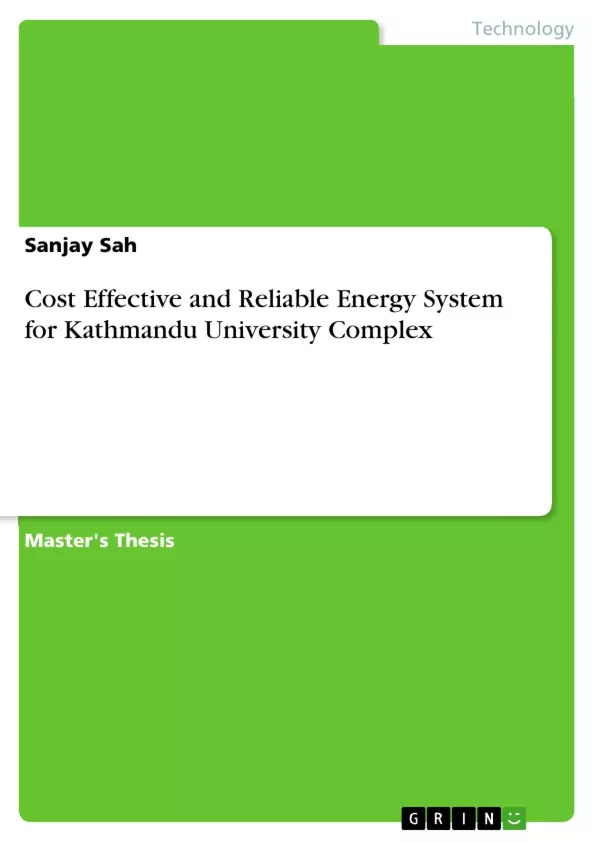This thesis presents the techno-economic feasibility study and reliability analysis of a hybrid energy system for Kathmandu University (KU), Dhulikhel, Nepal by using the resources available at premises. For the analysis, both on-grid and off-grid cases are considered. Various energy mix models are identified and optimized for the comparison purposes using HOMER (Hybrid Optimization Model for Multiple Energy Resources) software.
The results are also analyzed and compared based on their reliability using Monte Carlo Simulation in RAPTOR software. Based on various combinations and simulations, best cost-effective and reliable model has been proposed.
From this study, it is found that being a cost-effective model doesn’t mean it’s reliable too. In order to get the reliable supply, one may have to bear the extra cost to provide standby or emergency supply system. So, the cost plays an important role to determine what level of reliability is required.
Inhaltsverzeichnis (Table of Contents)
- Abstract
- Chapter 1: Introduction
- 1.1 Background
- 1.2 Statement of the Problem
- 1.3 Objectives
- 1.4 Scope and Limitations
- 1.5 Significance of the Study
- Chapter 2: Literature Review
- 2.1 Energy Demand and Consumption
- 2.2 Renewable Energy Sources
- 2.3 Hybrid Energy Systems
- 2.4 Optimization Techniques for Hybrid Energy Systems
- 2.5 Reliability and Availability Analysis of Power Systems
- Chapter 3: Methodology
- 3.1 Load Profile Estimation
- 3.2 Energy Resource Assessment
- 3.3 Hybrid Energy Mix Model Development
- 3.4 Cost Analysis using HOMER Software
- 3.5 Reliability and Availability Analysis using RAPTOR Software
- Chapter 4: Results and Discussion
- 4.1 Load Profile Analysis
- 4.2 Energy Resource Availability
- 4.3 Hybrid Energy Mix Model Selection
- 4.4 Cost Analysis and Comparison of Models
- 4.5 Reliability and Availability Analysis of Selected Models
- Chapter 5: Conclusion and Recommendations
Zielsetzung und Themenschwerpunkte (Objectives and Key Themes)
This dissertation aims to determine a cost-effective and reliable hybrid energy system for the Kathmandu University (KU) complex, taking into account the available energy resources and the KU's load demand throughout the year. The study analyzes various energy mix models using HOMER software for cost optimization and RAPTOR software for reliability and availability assessment.
- Cost-effective energy system design for KU
- Optimization of hybrid energy mix models using HOMER software
- Reliability and availability assessment of different energy mix models
- Comparison of various energy mix models based on cost and reliability metrics
- Determination of the most suitable energy system for KU considering both cost and reliability
Zusammenfassung der Kapitel (Chapter Summaries)
- Chapter 1: Introduction
- Chapter 2: Literature Review
- Chapter 3: Methodology
- Chapter 4: Results and Discussion
This chapter provides an overview of the study's background, problem statement, objectives, scope, limitations, and significance. It establishes the context for the research and highlights the importance of finding a cost-effective and reliable energy solution for KU.
This chapter reviews relevant literature on energy demand and consumption, renewable energy sources, hybrid energy systems, optimization techniques for hybrid energy systems, and reliability and availability analysis of power systems. It provides a comprehensive understanding of the existing research and theoretical frameworks related to the study's objectives.
This chapter describes the methodology employed in the research, including load profile estimation, energy resource assessment, hybrid energy mix model development, cost analysis using HOMER software, and reliability and availability analysis using RAPTOR software. It outlines the steps taken to collect data, develop models, and analyze the results.
This chapter presents the results of the study, including the load profile analysis, energy resource availability, hybrid energy mix model selection, cost analysis and comparison of models, and reliability and availability analysis of selected models. It analyzes the findings and discusses their implications for achieving a cost-effective and reliable energy system for KU.
Schlüsselwörter (Keywords)
The main keywords and focus topics of the dissertation are: cost-effective energy system, hybrid energy mix model, Kathmandu University, HOMER software, RAPTOR software, load profile, renewable energy resources, reliability, availability, cost analysis, optimization, grid, diesel generator, solar PV, batteries, Monte Carlo simulation.
- Citation du texte
- Sanjay Sah (Auteur), 2018, Cost Effective and Reliable Energy System for Kathmandu University Complex, Munich, GRIN Verlag, https://www.grin.com/document/437914



